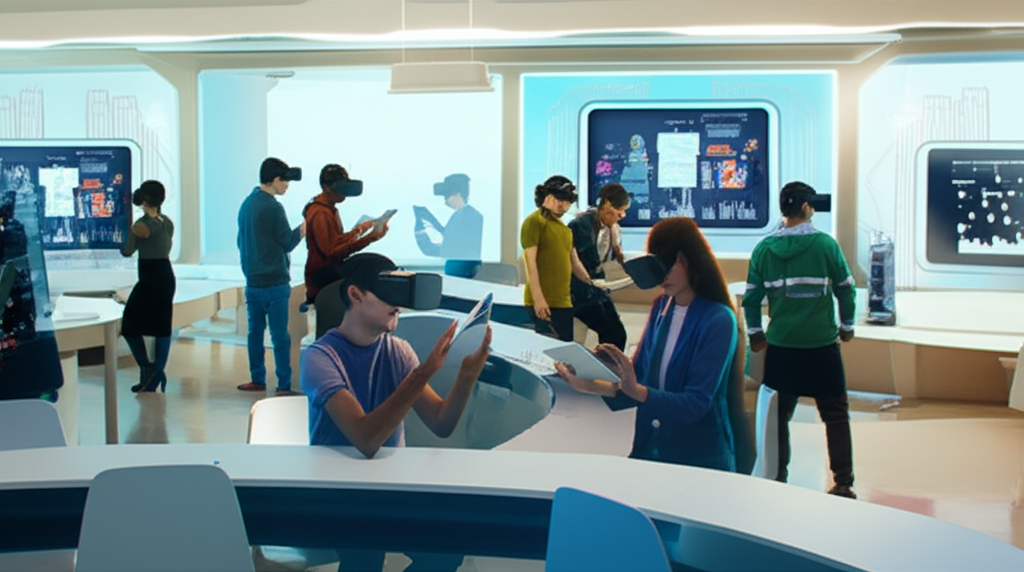
Table of Contents
Introduction
Imagine a classroom where every student, regardless of their location or learning style, has access to personalized, cutting-edge educational experiences that ignite curiosity and foster deep understanding. This vision is rapidly becoming a reality thanks to the accelerating advancements in education technology. For educators, students, and institutions alike, staying informed and adaptable to these innovations is no longer optional but essential. The landscape of learning is evolving at an unprecedented pace, reshaping how knowledge is delivered, absorbed, and applied in real-world contexts.
Technology’s impact on education is profound and multifaceted. In recent years, digital tools have transformed traditional classrooms into dynamic, interactive hubs of learning. The integration of artificial intelligence, virtual reality, and data analytics offers new ways to tailor instruction and engage learners more effectively than ever before. Studies show that students who experience technology-enhanced learning environments often demonstrate improved retention rates and higher motivation to learn. Yet, these benefits come with the responsibility to understand and implement such tools thoughtfully, ensuring equitable access and meaningful outcomes.
Educators today face the challenge of navigating an expanding array of technological options while balancing pedagogical goals and student needs. Meanwhile, learners must adapt to novel ways of interacting with information and peers. For example, the rise of online and blended learning models has dramatically changed how education is accessed and delivered, especially in the post-pandemic era. These shifts invite questions about best practices for effective implementation and highlight the importance of ongoing professional development for educators.
This rapid transformation creates opportunities and challenges that require careful consideration. It is natural to feel overwhelmed when confronted with the sheer volume of choices and the pace of change. However, understanding the key trends and how they intersect with teaching and learning practices empowers stakeholders to make informed decisions and innovate responsibly. Whether you are a teacher seeking to enhance your classroom, a student eager to embrace new learning tools, or an administrator planning future strategies, grasping these education technology trends is crucial.
What You’ll Learn in This Guide
This comprehensive guide explores the latest trends and innovations shaping the future of learning through technology. We break down complex concepts and provide practical insights to help you navigate this evolving field confidently. Here’s a snapshot of what you’ll discover:
- Major Current Trends: We delve into groundbreaking technologies like artificial intelligence, virtual and augmented reality, and the growing adoption of online and blended learning models. You’ll learn how these trends are transforming educational experiences across various settings.
- Applications and Benefits: Understand how education technology enhances accessibility, engagement, and learning outcomes. From personalized learning powered by data analytics to collaboration tools fostering communication, we cover it all to illustrate the potential of these innovations.
- Challenges to Consider: Every innovation brings hurdles. We discuss issues such as the digital divide that affects equitable access, the need for teacher training and support, and critical considerations around data privacy and security in digital learning environments.
- Future Outlook and Adoption Strategies: Gain insights into the emerging advancements that will define education technology in the next decade, and learn practical guidance on when and how to incorporate new tools effectively in educational settings for maximum impact.
Looking ahead, this guide serves as a valuable roadmap through the exciting yet complex world of education technology. By understanding these core aspects, you can better position yourself or your institution to harness the power of innovation to enhance teaching and learning experiences.
As we dive deeper into each trend and its implications, you’ll gain clarity on how technology can be integrated thoughtfully to support diverse educational goals. Whether you are interested in the potential of AI to automate tasks and personalize instruction or curious about immersive VR environments that captivate and motivate students, this overview prepares you for a deeper exploration.
The insights you gain will empower you to make informed decisions, advocate for effective technology use, and anticipate future developments. Join us on this journey to explore how education technology is reshaping the future of learning—making it more inclusive, engaging, and impactful than ever before. Let’s embark on this transformative path together and unlock the full potential of education technology innovations.

The rapid advancement of technology continues to reshape the educational landscape in profound ways. As classrooms evolve from traditional setups to more interactive and technology-driven environments, staying informed about the latest education technology trends is essential for educators, students, and institutions alike. This discussion dives deeply into some of the most impactful innovations transforming how we learn and teach, highlighting not only the trends themselves but also the practical applications and benefits that come with embracing these tools. Understanding these shifts enables stakeholders to make informed decisions that ultimately enhance educational outcomes and foster more engaging learning experiences.
Current Major Trends in Education Technology
Education technology today is defined by a convergence of powerful innovations that are personally transforming how instruction is delivered and how students engage with learning materials. Among the most influential trends are Artificial Intelligence (AI) and Machine Learning (ML), Virtual and Augmented Reality (VR/AR), and the expansion of Online and Blended Learning Models. AI and ML are revolutionizing education by enabling personalized learning paths aligned with each student’s unique needs while automating time-consuming administrative tasks to free educators to focus more on teaching. Virtual and augmented reality technologies offer immersive experiences that engage students more deeply by simulating complex concepts and real-world environments, dramatically enhancing understanding and retention. Meanwhile, online and hybrid learning methods have gained massive traction following the pandemic, providing greater flexibility and access to education worldwide. To fully grasp this concept, it helps to understand technology integration in classrooms first.
These major trends not only reflect the current state of education technology but also signal where the future is headed. Institutions implementing AI-driven adaptive learning systems find they can better track student progress and customize content delivery accordingly. VR and AR applications range from virtual science labs to historical site tours, creating highly interactive lessons. Meanwhile, online platforms support synchronous and asynchronous learning, catering to diverse student preferences and schedules. Educators and administrators must navigate the benefits and challenges associated with these technologies, such as ensuring equitable access and maintaining student engagement in virtual setups, while leveraging their potential to enhance instructional effectiveness.
Key Aspects of Current Education Technology Trends
Here are some of the core elements defining today’s education technology landscape:
- Artificial Intelligence and Machine Learning: AI-powered systems enable personalized education by analyzing student data to tailor instructional content, pacing, and assessment methods. For example, AI can identify learner strengths and weaknesses, adjusting difficulty levels dynamically to optimize engagement and progression.
- Virtual and Augmented Reality: VR and AR technologies immerse students in realistic simulations that bring abstract concepts to life. Applications include virtual field trips, 3D anatomy explorations, and interactive science experiments that elevate student interest and knowledge retention.
- Online and Blended Learning Models: The shift toward remote and hybrid education increases accessibility by removing geographic and scheduling barriers. These models combine face-to-face interactions with digital content delivery, supporting diverse learning styles and offering flexible pacing opportunities.
- Automation and Administrative Efficiency: AI-powered automation streamlines routine tasks such as grading, attendance tracking, and data management. This reduces educator workload, allowing more time for personalized student support and curriculum development.
Applications and Benefits of Education Technology
Education technology application extends beyond classroom tools; it fundamentally enhances accessibility, engagement, and learning outcomes across diverse educational settings. Technologies like data analytics empower educators to customize content delivery and intervene effectively, while collaboration platforms enable meaningful interaction regardless of physical location. These advancements foster inclusive environments where all students can thrive, supported by adaptive technologies and networked communication tools.
The benefits are multifaceted: students experience learning tailored to their unique pace and style, collaborative projects gain efficiency through seamless technologies, and educational institutions leverage data-driven insights to refine curricula continually. These applications contribute not only to improved academic performance but also to the development of critical 21st-century skills such as digital literacy, problem-solving, and teamwork. For a detailed breakdown of this step, see our guide on enhancing learning experiences with technology integration.
Important Considerations for Education Technology Applications
Below are critical facets highlighting how education technology contributes to better learning environments:
- Personalized Learning: Leveraging data analytics, educators create customized learning plans that match individual student interests, abilities, and progress markers, resulting in more effective knowledge acquisition and motivation.
- Collaboration and Communication Tools: Digital platforms facilitate interactive group work, instant teacher-student feedback, and peer-to-peer engagement, overcoming traditional barriers posed by distance or scheduling restrictions.
- Data-Driven Decision Making: Learning analytics provide actionable insights into curriculum effectiveness and student comprehension trends, enabling continuous instructional refinement and targeted interventions.
- Accessibility Enhancement: Technology breaks down physical and temporal barriers, giving students with disabilities and those in remote locations equal opportunities to access quality education through assistive tools and remote platforms.

Conclusion
Education technology is rapidly reshaping the landscape of learning, offering transformative tools and approaches that empower both educators and students alike. As explored throughout this guide, innovations such as artificial intelligence and machine learning are driving personalized learning experiences that cater to individual student needs, helping to foster deeper understanding and greater motivation. Virtual and augmented reality technologies create immersive environments that engage learners in ways traditional classrooms cannot, while online and blended learning models have expanded access to education beyond physical boundaries. These evolving technologies collectively unlock new potential for improving educational outcomes and equity.
However, along with these promising advancements come important challenges that must be thoughtfully addressed. The digital divide remains a significant barrier to equitable access, requiring concerted efforts to ensure all students have the necessary devices and connectivity. Teacher training and ongoing professional development are critical to help educators effectively integrate these tools into their pedagogy and feel confident using new platforms. Additionally, data privacy and security must be prioritized to safeguard sensitive student information as education increasingly moves into digital spaces. Recognizing and tackling these hurdles is essential for realizing the full benefits of education technology in meaningful and sustainable ways.
To best harness these innovations, schools and educators are encouraged to take deliberate, strategic steps. Begin by carefully assessing your educational objectives and the specific needs of your learners before selecting any technology. Pilot programs offer invaluable opportunities to test new tools on a smaller scale, gather actionable feedback from users, and identify potential issues early on. From there, scaling adoption should be accompanied by continuous evaluation of effectiveness and challenges, allowing for timely adjustments that optimize impact. Prioritizing equitable access and robust teacher support throughout this process will significantly improve integration success.
Looking toward the future, education technology is expected to continue advancing with exciting developments on the horizon. Staying informed about emerging trends and innovations will enable educators and institutions to adapt and evolve, ensuring that teaching and learning practices remain relevant and impactful in an ever-changing world. By embracing thoughtful adoption and empowering stakeholders through knowledge and support, education technology can help create more inclusive, engaging, and effective learning environments for all students.
As you move forward, remember that the journey of integrating technology into education is ongoing and collaborative. Keep exploring new tools, share insights with peers, and remain open to change. Together, we can unlock the full potential of these innovations to transform education and better prepare learners for the challenges and opportunities ahead. For those interested in deepening their understanding, continue exploring emerging education technology trends to stay ahead in this dynamic field.
Frequently Asked Questions
-
What are the most important education technology trends to watch in 2024?
- Key trends include AI-driven personalization, the rise of immersive VR/AR learning, and expanding online and hybrid education models.
-
How can schools address the digital divide?
- By ensuring equitable access to devices and internet connectivity and providing extra support for underserved students.
-
What role do teachers play in education technology adoption?
- Teachers are central to successful integration, requiring ongoing training and support to effectively use and adapt to new tools.
